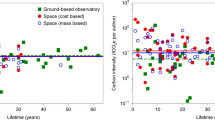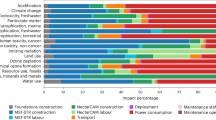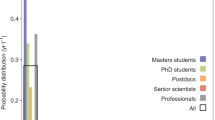Abstract
Research infrastructures have been identified as an important source of greenhouse gas emissions of astronomical research. Based on a comprehensive inventory of 1,211 ground-based observatories and space missions, we assessed the evolution of the number of astronomical facilities and their carbon footprint from 1945 to 2022. We found that space missions dominate greenhouse gas emissions in astronomy, showing an important peak at the end of the 1960s, followed by a decrease that has turned again into a rise over the last decade. Extrapolating past trends, we predict that greenhouse gas emissions from astronomical facilities will experience no strong decline in the future, and may even rise substantially, unless research practices are changed. We demonstrate that a continuing growth in the number of operating astronomical facilities is not environmentally sustainable. These findings should motivate the astronomical community to reflect about the necessary evolutions that would put astronomical research on a sustainable path.
This is a preview of subscription content, access via your institution
Access options
Access Nature and 54 other Nature Portfolio journals
Get Nature+, our best-value online-access subscription
$29.99 / 30 days
cancel any time
Subscribe to this journal
Receive 12 digital issues and online access to articles
$119.00 per year
only $9.92 per issue
Buy this article
- Purchase on SpringerLink
- Instant access to full article PDF
Prices may be subject to local taxes which are calculated during checkout



Similar content being viewed by others
Data availability
All data used for this work are available via Zenodo at https://zenodo.org/records/12568160 (ref. 44).
Code availability
All code used for this work is available via Zenodo at https://zenodo.org/records/12568160 (ref. 44).
References
Rosen, J. A greener culture. Nature 546, 565–567 (2017).
Askenazy, P. et al. Intégrer les enjeux environnementaux à la conduite de la recherche–une responsabilité éthique. PhD thesis, Comité d’éthique du CNRS (2022).
Stevens, A. R. H., Bellstedt, S., Elahi, P. J. & Murphy, M. T. The imperative to reduce carbon emissions in astronomy. Nat. Astron. 4, 843–851 (2020).
Burtscher, L. et al. The carbon footprint of large astronomy meetings. Nat. Astron. 4, 823–825 (2020).
Jahnke, K. et al. An astronomical institute’s perspective on meeting the challenges of the climate crisis. Nat. Astron. 4, 812–815 (2020).
Van der Tak, F. et al. The carbon footprint of astronomy research in the Netherlands. Nat. Astron. 5, 1195–1198 (2021).
Martin, P. et al. A comprehensive assessment of the carbon footprint of an astronomical institute. Nat. Astron. 6, 1219–1222 (2022).
McCann, K. L., Nance, C., Sebastian, G. & Walawender, J. A path to net-zero carbon emissions at the W. M. Keck Observatory. Nat. Astron. 6, 1223–1227 (2022).
Kruithof, G. et al. The energy consumption and carbon footprint of the LOFAR telescope. Exp. Astron. 56, 687–714 (2023).
Viole, I., Valenzuela-Venegas, G., Zeyringer, M. & Sartori, S. A renewable power system for an off-grid sustainable telescope fueled by solar power, batteries and green hydrogen. Energy 282, 128570 (2023).
Knödlseder, J. et al. Estimate of the carbon footprint of astronomical research infrastructures. Nat. Astron. 6, 503–513 (2022).
Riahi, K. et al. in Climate Change 2022: Mitigation of Climate Change. Contribution of Working Group III to the Sixth Assessment Report of the Intergovernmental Panel on Climate Change (eds P.R. Shukla et al.) (Cambridge Univ. Press, 2022).
Friedlingstein, P. et al. Global carbon budget 2022. Earth Syst. Sci. Data 14, 4811–4900 (2022).
Direct Air Capture 2022 (IEA, 2022); www.iea.org/reports/direct-air-capture-2022
Ho, D. T. Carbon dioxide removal is not a current climate solution–we need to change the narrative. Nature 616, 9 (2023).
Editorial. EU climate policy is dangerously reliant on untested carbon-capture technology. Nature 626, 456 (2024).
Dziejarski, B., Krzyżyńska, R. & Andersson, K. Current status of carbon capture, utilization, and storage technologies in the global economy: A survey of technical assessment. Fuel 342, 127776 (2023).
Jackson, R. B. et al. Global fossil carbon emissions rebound near pre-COVID-19 levels. Environ. Res. Lett. 17, 031001 (2022).
Jackson, T. & Victor, P. A. Unraveling the claims for (and against) green growth. Science 366, 950–951 (2019).
Hickel, J. & Kallis, G. Is green growth possible? New Political Econ. 25, 469–486 (2020).
Hannesson, R. Are we seeing dematerialization of world GDP? Biophys. Econ. Sust. 6, 4 (2021).
Murphy, T. W. Limits to economic growth. Nat. Physics 18, 844–847 (2022).
Vogel, J. & Hickel, J. Is green growth happening? An empirical analysis of achieved versus Paris-compliant CO2–GDP decoupling in high-income countries. Lancet Planet. Health 7, 759–769 (2023).
Global Letter (Million Advocates for Sustainable Science, 2022); www.sustainablescienceadvocates.org/wp-content/uploads/2022/07/Million-Advocates-Global-Letter.pdf
Flahaut, J., Van der Bogert, C. H. & Vincent-Bonnieu, S. Scientific perspectives on lunar exploration in Europe. NPJ Microgravity 9, 50 (2023).
Schneider, J., Kervella, P. & Labeyrie, A. Astronomy from the Moon in the next decades: from exoplanets to cosmology in visible light and beyond, Philos. Trans. R. Soc. A 382, 20230071 (2024).
Knödlseder, J. in Climate Change for Astronomers: Causes, Consequences, and Communication (ed. Rector, T.) Chap. 18 (IOP Astronomy, 2024).
Resolution on ESA Accelerating the Use of Space in Europe (ESA Council, 2022); https://europeanspaceflight.com/wp-content/uploads/2022/11/Resolution_1_CM22.pdf
Plan climat-biodiversité et transition écologique de l’Enseignement supérieur et de la Recherche (Ministère de l’enseignement supérieur et de la recherche, 2022); https://services.dgesip.fr/fichiers/Plan_climat_MESR_4.pdf
Chang, A., Anderson, C. & Aden, N. Pathways to Net-Zero: SBTi Technical Summary (Science Based Targets, 2021); https://sciencebasedtargets.org/resources/files/Pathway-to-Net-Zero.pdf
Lukac, M. R. & Miller, R. J. List of Active Professional Observatories (United States Naval Observatory, 2000).
Leverington, D. Observatories and Telescopes of Modern Times (Cambridge Univ. Press, 2017).
Thompson, A. R., Moran, J. M. & Swenson Jr, G. W. Interferometry and Synthesis in Radio Astronomy (Springer, 2017).
Baars, J. W. M. & Kärcher, H. J. Radio Telescope Reflectors (Springer, 2018).
Orchiston, W., Robertson, P. & Woodruff, T. S. Golden Years of Australian Radio Astronomy (Springer, 2021).
Kellermann, K. I., Bouton, E. N. & Brandt, S. S. Open Skies (Springer, 2021).
Krebs, G. D. Gunter’s Space Page. https://space.skyrocket.de (2023).
Wilson, A. R. Advanced Methods of Life Cycle Assessment for Space Systems. PhD thesis, Univ. of Strathclyde (2019).
Wilson, A. R. & Vasile, M. Life cycle engineering of space systems: preliminary findings. Adv. Space Res. 72, 2917–2935 (2023).
Dos Santos Illa, G., Boix, M., Knödlseder, J., Garnier, P. & Montastruc, L. Assessment of the environmental impacts of the Cherenkov Telescope Array mid-sized telescope. Nat. Astron. https://doi.org/10.1038/s41550-024-02326-4 (2024).
Barret, D. et al. Life cycle assessment of the Athena X-ray Integral Field Unit. Exp. Astron. 57, 19 (2024).
Jascheck, C. The size of the astronomical community. Scientometrics 22, 265–282 (1991).
Kaya, Y. & Keiichi, K. Environment, Energy, and Economy: Strategies for Sustainability (United Nations Univ. Press, 1997).
Knödlseder, J. The projected carbon footprint of astronomical facilities calls for changes in research practices. Zenodo https://doi.org/10.5281/zenodo.12568159 (2024).
Hunter, J. D. Matplotlib: a 2-D graphics environment. Comput. Sci. Eng. 9, 90–95 (2007).
Acknowledgements
This research has made use of NASA’s Astrophysics Data System Bibliographic Services (ADS). We thank K. Lockhart for her help with using that service. We further thank D. Barret for useful discussions. This work has also benefited from discussions within the research group and cross-disciplinary collective Labos 1point5, and within the grassroots movement Astronomers for Planet Earth. We thank all members for their engagement and support. This work has made use of the Python 2D plotting library matplotlib45.
Author information
Authors and Affiliations
Contributions
J.K. developed the method, gathered and analysed the data and drafted the paper. P.G. helped with the collection of some data. All authors contributed to the definition of the analysis method, the elaboration of the discussion section and the review of the manuscript.
Corresponding author
Ethics declarations
Competing interests
The authors declare no competing interests.
Peer review
Peer review information
Nature Astronomy thanks Alison Farmer, Joshua Kace and Andrew Wilson for their contribution to the peer review of this work.
Additional information
Publisher’s note Springer Nature remains neutral with regard to jurisdictional claims in published maps and institutional affiliations.
Supplementary information
Supplementary Information
Supplementary Figs. 1–14, Tables 1–3 and Discussion.
Rights and permissions
Springer Nature or its licensor (e.g. a society or other partner) holds exclusive rights to this article under a publishing agreement with the author(s) or other rightsholder(s); author self-archiving of the accepted manuscript version of this article is solely governed by the terms of such publishing agreement and applicable law.
About this article
Cite this article
Knödlseder, J., Coriat, M., Garnier, P. et al. Scenarios of future annual carbon footprints of astronomical research infrastructures. Nat Astron (2024). https://doi.org/10.1038/s41550-024-02346-0
Received:
Accepted:
Published:
DOI: https://doi.org/10.1038/s41550-024-02346-0



